Financial Decision Making, Ratio Analysis, and Accounting Functions
VerifiedAdded on 2021/02/21
|12
|3620
|73
Report
AI Summary
This report provides a comprehensive analysis of financial decision-making and accounting functions within a business context, using Tesco as a case study. It examines the critical roles of accounting and finance in organizational operations, emphasizing their importance in recording financial transactions, facilitating decision-making, and ensuring regulatory compliance. The report further delves into the financial performance of Alpha Limited through ratio analysis, including return on capital employed, net profit margin, and current ratio calculations. It interprets these ratios to assess the company's financial health, efficiency, and liquidity, offering insights and recommendations for improvement. The analysis highlights the significance of both accounting and finance functions in strategic planning, resource allocation, and achieving long-term business sustainability.

Financial Decision Making
Making
Making
Paraphrase This Document
Need a fresh take? Get an instant paraphrase of this document with our AI Paraphraser
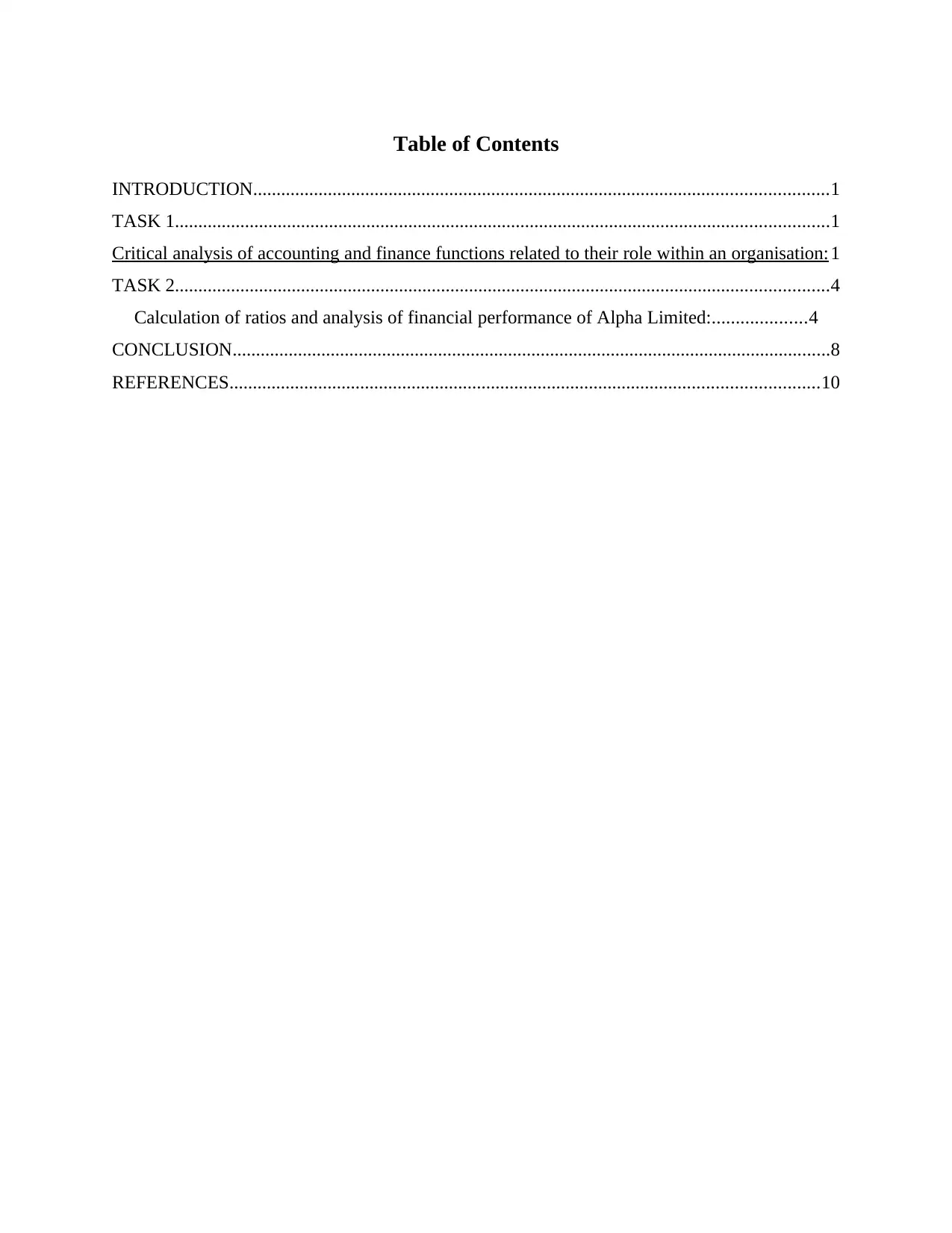
Table of Contents
INTRODUCTION...........................................................................................................................1
TASK 1............................................................................................................................................1
Critical analysis of accounting and finance functions related to their role within an organisation: 1
TASK 2............................................................................................................................................4
Calculation of ratios and analysis of financial performance of Alpha Limited:....................4
CONCLUSION................................................................................................................................8
REFERENCES..............................................................................................................................10
INTRODUCTION...........................................................................................................................1
TASK 1............................................................................................................................................1
Critical analysis of accounting and finance functions related to their role within an organisation: 1
TASK 2............................................................................................................................................4
Calculation of ratios and analysis of financial performance of Alpha Limited:....................4
CONCLUSION................................................................................................................................8
REFERENCES..............................................................................................................................10
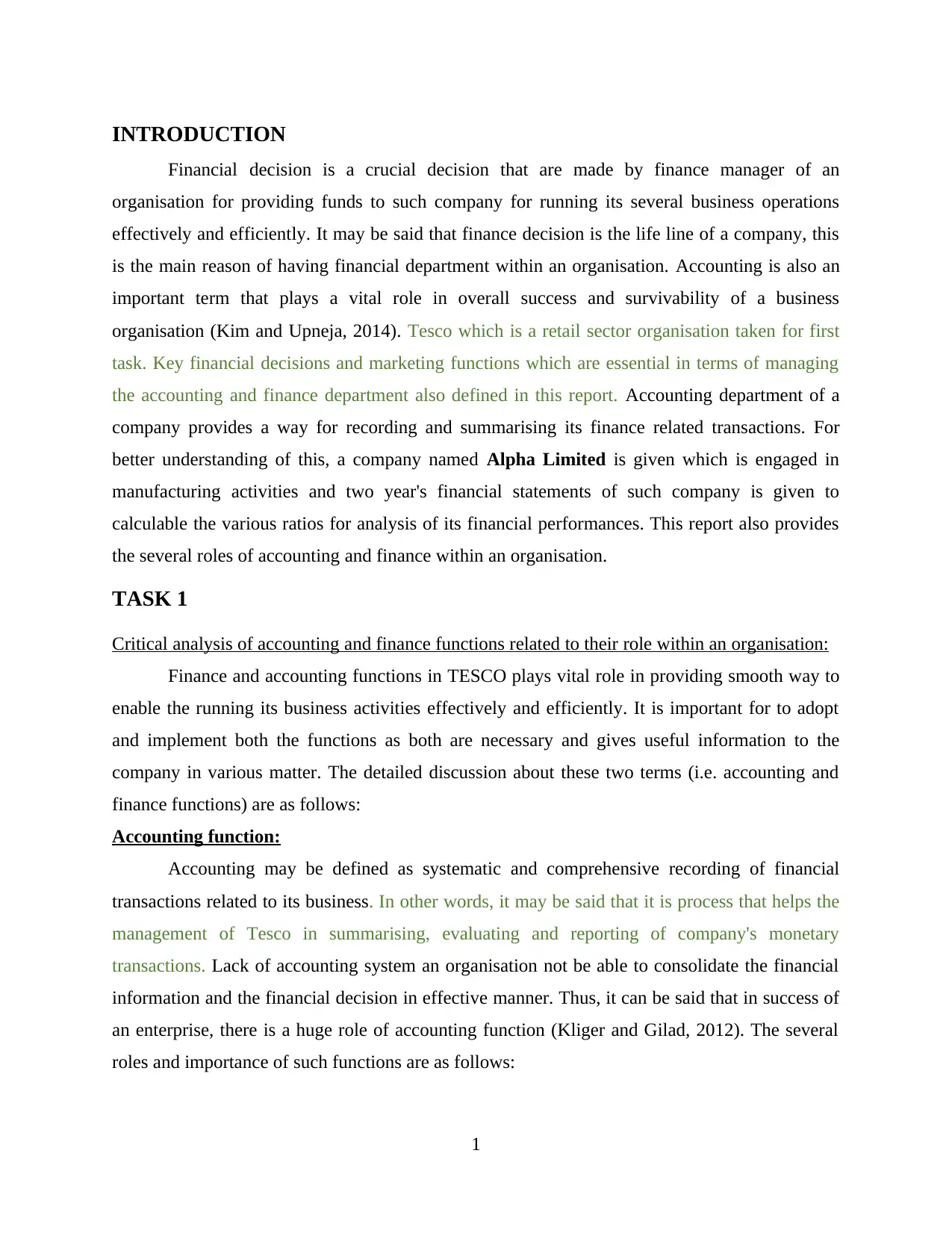
INTRODUCTION
Financial decision is a crucial decision that are made by finance manager of an
organisation for providing funds to such company for running its several business operations
effectively and efficiently. It may be said that finance decision is the life line of a company, this
is the main reason of having financial department within an organisation. Accounting is also an
important term that plays a vital role in overall success and survivability of a business
organisation (Kim and Upneja, 2014). Tesco which is a retail sector organisation taken for first
task. Key financial decisions and marketing functions which are essential in terms of managing
the accounting and finance department also defined in this report. Accounting department of a
company provides a way for recording and summarising its finance related transactions. For
better understanding of this, a company named Alpha Limited is given which is engaged in
manufacturing activities and two year's financial statements of such company is given to
calculable the various ratios for analysis of its financial performances. This report also provides
the several roles of accounting and finance within an organisation.
TASK 1
Critical analysis of accounting and finance functions related to their role within an organisation:
Finance and accounting functions in TESCO plays vital role in providing smooth way to
enable the running its business activities effectively and efficiently. It is important for to adopt
and implement both the functions as both are necessary and gives useful information to the
company in various matter. The detailed discussion about these two terms (i.e. accounting and
finance functions) are as follows:
Accounting function:
Accounting may be defined as systematic and comprehensive recording of financial
transactions related to its business. In other words, it may be said that it is process that helps the
management of Tesco in summarising, evaluating and reporting of company's monetary
transactions. Lack of accounting system an organisation not be able to consolidate the financial
information and the financial decision in effective manner. Thus, it can be said that in success of
an enterprise, there is a huge role of accounting function (Kliger and Gilad, 2012). The several
roles and importance of such functions are as follows:
1
Financial decision is a crucial decision that are made by finance manager of an
organisation for providing funds to such company for running its several business operations
effectively and efficiently. It may be said that finance decision is the life line of a company, this
is the main reason of having financial department within an organisation. Accounting is also an
important term that plays a vital role in overall success and survivability of a business
organisation (Kim and Upneja, 2014). Tesco which is a retail sector organisation taken for first
task. Key financial decisions and marketing functions which are essential in terms of managing
the accounting and finance department also defined in this report. Accounting department of a
company provides a way for recording and summarising its finance related transactions. For
better understanding of this, a company named Alpha Limited is given which is engaged in
manufacturing activities and two year's financial statements of such company is given to
calculable the various ratios for analysis of its financial performances. This report also provides
the several roles of accounting and finance within an organisation.
TASK 1
Critical analysis of accounting and finance functions related to their role within an organisation:
Finance and accounting functions in TESCO plays vital role in providing smooth way to
enable the running its business activities effectively and efficiently. It is important for to adopt
and implement both the functions as both are necessary and gives useful information to the
company in various matter. The detailed discussion about these two terms (i.e. accounting and
finance functions) are as follows:
Accounting function:
Accounting may be defined as systematic and comprehensive recording of financial
transactions related to its business. In other words, it may be said that it is process that helps the
management of Tesco in summarising, evaluating and reporting of company's monetary
transactions. Lack of accounting system an organisation not be able to consolidate the financial
information and the financial decision in effective manner. Thus, it can be said that in success of
an enterprise, there is a huge role of accounting function (Kliger and Gilad, 2012). The several
roles and importance of such functions are as follows:
1
⊘ This is a preview!⊘
Do you want full access?
Subscribe today to unlock all pages.

Trusted by 1+ million students worldwide
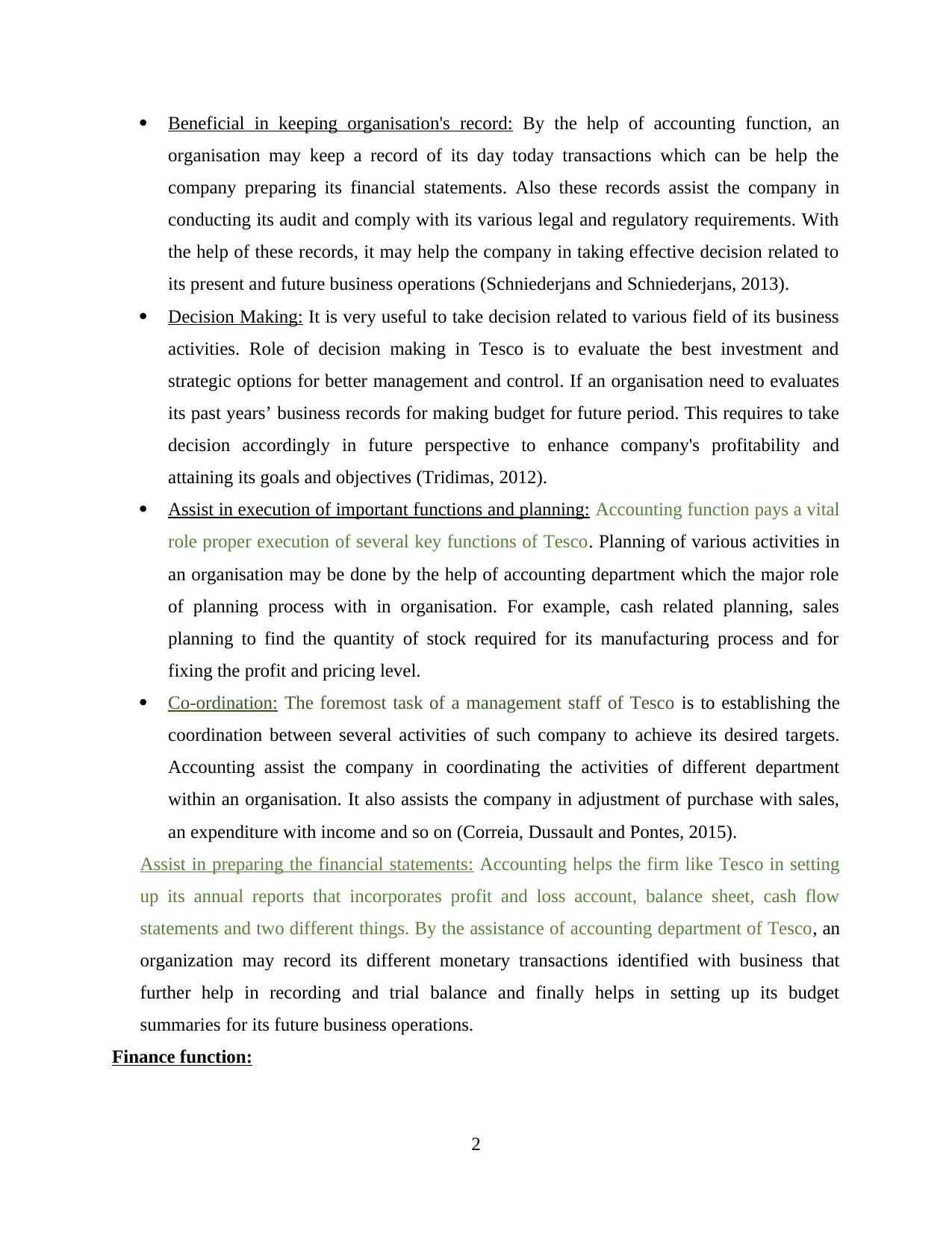
Beneficial in keeping organisation's record: By the help of accounting function, an
organisation may keep a record of its day today transactions which can be help the
company preparing its financial statements. Also these records assist the company in
conducting its audit and comply with its various legal and regulatory requirements. With
the help of these records, it may help the company in taking effective decision related to
its present and future business operations (Schniederjans and Schniederjans, 2013).
Decision Making: It is very useful to take decision related to various field of its business
activities. Role of decision making in Tesco is to evaluate the best investment and
strategic options for better management and control. If an organisation need to evaluates
its past years’ business records for making budget for future period. This requires to take
decision accordingly in future perspective to enhance company's profitability and
attaining its goals and objectives (Tridimas, 2012).
Assist in execution of important functions and planning: Accounting function pays a vital
role proper execution of several key functions of Tesco. Planning of various activities in
an organisation may be done by the help of accounting department which the major role
of planning process with in organisation. For example, cash related planning, sales
planning to find the quantity of stock required for its manufacturing process and for
fixing the profit and pricing level.
Co-ordination: The foremost task of a management staff of Tesco is to establishing the
coordination between several activities of such company to achieve its desired targets.
Accounting assist the company in coordinating the activities of different department
within an organisation. It also assists the company in adjustment of purchase with sales,
an expenditure with income and so on (Correia, Dussault and Pontes, 2015).
Assist in preparing the financial statements: Accounting helps the firm like Tesco in setting
up its annual reports that incorporates profit and loss account, balance sheet, cash flow
statements and two different things. By the assistance of accounting department of Tesco, an
organization may record its different monetary transactions identified with business that
further help in recording and trial balance and finally helps in setting up its budget
summaries for its future business operations.
Finance function:
2
organisation may keep a record of its day today transactions which can be help the
company preparing its financial statements. Also these records assist the company in
conducting its audit and comply with its various legal and regulatory requirements. With
the help of these records, it may help the company in taking effective decision related to
its present and future business operations (Schniederjans and Schniederjans, 2013).
Decision Making: It is very useful to take decision related to various field of its business
activities. Role of decision making in Tesco is to evaluate the best investment and
strategic options for better management and control. If an organisation need to evaluates
its past years’ business records for making budget for future period. This requires to take
decision accordingly in future perspective to enhance company's profitability and
attaining its goals and objectives (Tridimas, 2012).
Assist in execution of important functions and planning: Accounting function pays a vital
role proper execution of several key functions of Tesco. Planning of various activities in
an organisation may be done by the help of accounting department which the major role
of planning process with in organisation. For example, cash related planning, sales
planning to find the quantity of stock required for its manufacturing process and for
fixing the profit and pricing level.
Co-ordination: The foremost task of a management staff of Tesco is to establishing the
coordination between several activities of such company to achieve its desired targets.
Accounting assist the company in coordinating the activities of different department
within an organisation. It also assists the company in adjustment of purchase with sales,
an expenditure with income and so on (Correia, Dussault and Pontes, 2015).
Assist in preparing the financial statements: Accounting helps the firm like Tesco in setting
up its annual reports that incorporates profit and loss account, balance sheet, cash flow
statements and two different things. By the assistance of accounting department of Tesco, an
organization may record its different monetary transactions identified with business that
further help in recording and trial balance and finally helps in setting up its budget
summaries for its future business operations.
Finance function:
2
Paraphrase This Document
Need a fresh take? Get an instant paraphrase of this document with our AI Paraphraser
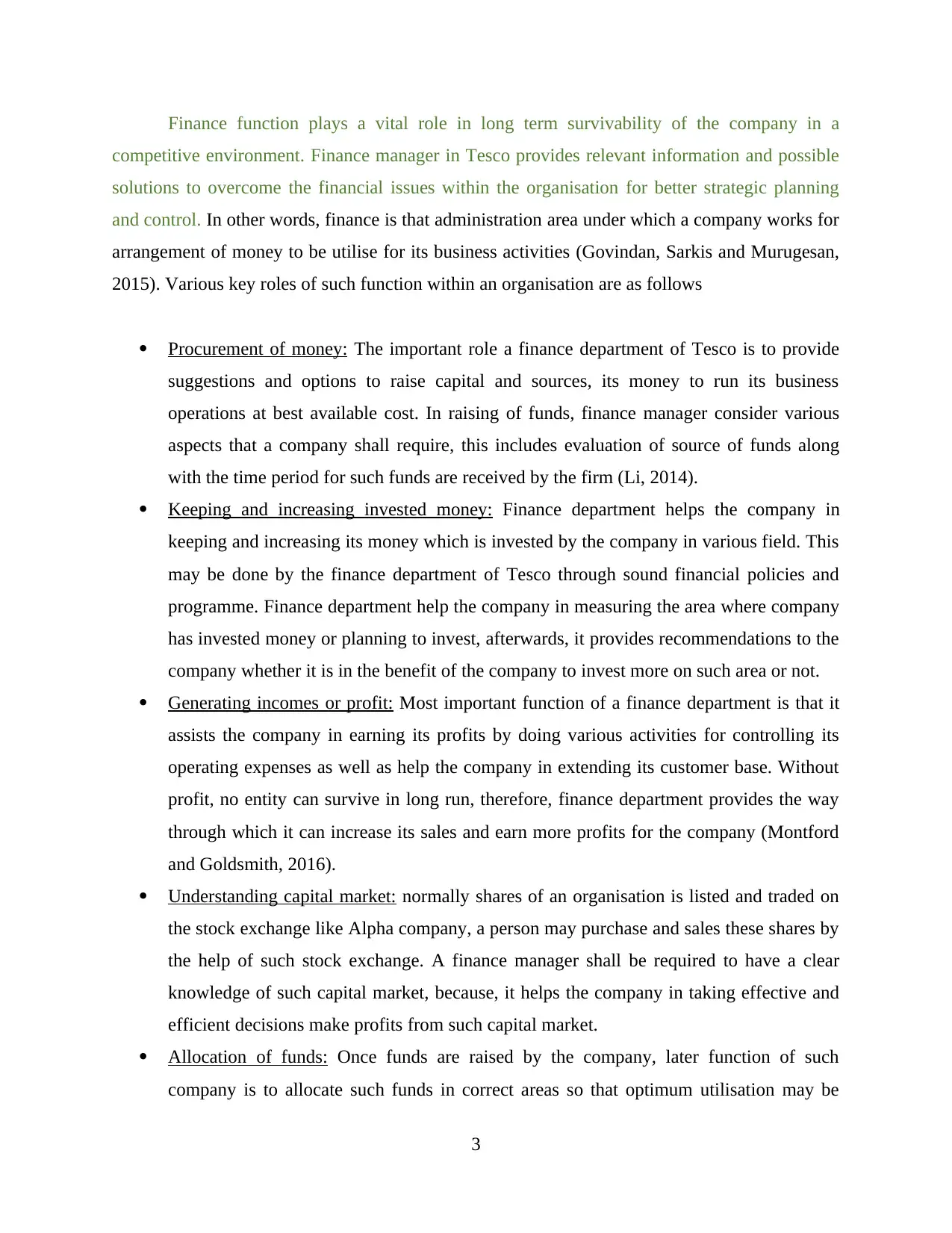
Finance function plays a vital role in long term survivability of the company in a
competitive environment. Finance manager in Tesco provides relevant information and possible
solutions to overcome the financial issues within the organisation for better strategic planning
and control. In other words, finance is that administration area under which a company works for
arrangement of money to be utilise for its business activities (Govindan, Sarkis and Murugesan,
2015). Various key roles of such function within an organisation are as follows
Procurement of money: The important role a finance department of Tesco is to provide
suggestions and options to raise capital and sources, its money to run its business
operations at best available cost. In raising of funds, finance manager consider various
aspects that a company shall require, this includes evaluation of source of funds along
with the time period for such funds are received by the firm (Li, 2014).
Keeping and increasing invested money: Finance department helps the company in
keeping and increasing its money which is invested by the company in various field. This
may be done by the finance department of Tesco through sound financial policies and
programme. Finance department help the company in measuring the area where company
has invested money or planning to invest, afterwards, it provides recommendations to the
company whether it is in the benefit of the company to invest more on such area or not.
Generating incomes or profit: Most important function of a finance department is that it
assists the company in earning its profits by doing various activities for controlling its
operating expenses as well as help the company in extending its customer base. Without
profit, no entity can survive in long run, therefore, finance department provides the way
through which it can increase its sales and earn more profits for the company (Montford
and Goldsmith, 2016).
Understanding capital market: normally shares of an organisation is listed and traded on
the stock exchange like Alpha company, a person may purchase and sales these shares by
the help of such stock exchange. A finance manager shall be required to have a clear
knowledge of such capital market, because, it helps the company in taking effective and
efficient decisions make profits from such capital market.
Allocation of funds: Once funds are raised by the company, later function of such
company is to allocate such funds in correct areas so that optimum utilisation may be
3
competitive environment. Finance manager in Tesco provides relevant information and possible
solutions to overcome the financial issues within the organisation for better strategic planning
and control. In other words, finance is that administration area under which a company works for
arrangement of money to be utilise for its business activities (Govindan, Sarkis and Murugesan,
2015). Various key roles of such function within an organisation are as follows
Procurement of money: The important role a finance department of Tesco is to provide
suggestions and options to raise capital and sources, its money to run its business
operations at best available cost. In raising of funds, finance manager consider various
aspects that a company shall require, this includes evaluation of source of funds along
with the time period for such funds are received by the firm (Li, 2014).
Keeping and increasing invested money: Finance department helps the company in
keeping and increasing its money which is invested by the company in various field. This
may be done by the finance department of Tesco through sound financial policies and
programme. Finance department help the company in measuring the area where company
has invested money or planning to invest, afterwards, it provides recommendations to the
company whether it is in the benefit of the company to invest more on such area or not.
Generating incomes or profit: Most important function of a finance department is that it
assists the company in earning its profits by doing various activities for controlling its
operating expenses as well as help the company in extending its customer base. Without
profit, no entity can survive in long run, therefore, finance department provides the way
through which it can increase its sales and earn more profits for the company (Montford
and Goldsmith, 2016).
Understanding capital market: normally shares of an organisation is listed and traded on
the stock exchange like Alpha company, a person may purchase and sales these shares by
the help of such stock exchange. A finance manager shall be required to have a clear
knowledge of such capital market, because, it helps the company in taking effective and
efficient decisions make profits from such capital market.
Allocation of funds: Once funds are raised by the company, later function of such
company is to allocate such funds in correct areas so that optimum utilisation may be
3

done. For allocating the funds at right direction, there is need of finance department to
take effective decision by considering the all related factors that includes size of an
organisation, its growth capability and so on (Ogiela, 2013).
TASK 2
Calculation of ratios and analysis of financial performance of Alpha Limited:
Ratio analysis is a technical term in which company compares its line item which are
stated in its financial statements. This analysis provides various useful information about an
organisation's past operations that assist the company in making better future in organisational
perspective. The main benefits from these financial ratios may be achieved by comparing such
ratios with other company's ratio or with same company's other year's ratio (Gal, Stewart and
Hanne, 2013). Calculations of various ratio analysis of company Alpha Limited are as follows:
Return on capital employed:
This ratio is very useful for company itself as well as for its key stakeholders to evaluate
the performances of company in utilising its capital for earning its profits (Frias‐Aceituno,
Rodríguez‐Ariza and Garcia‐Sánchez, 2014). In other words, it may be said that it is a financial
ratio that helps the company in evaluation of its financial performance, which is calculated by
dividing net income by shareholder's funds. Return on equity gives an insight view to the
investors that whether company is handling the funds efficiently that are provided by
shareholder's. Calculation is as follows:
Return on capital employed: Net profit/ capital employed*100 (Amount in £000)
Particulars 2018 2017
Net profit 262.5 300
Capital employed 2925 1912.5
Return on capital employed 8.97 15.69
Interpretation:
From the above results, it is evident that Alpha Limited has 8.97 in year 2018 and 15.69
return on capital equity in year 2017. This shows that such company has working well and not
efficient in utilising its capital effectively, due to this, such company has less return on equity in
4
take effective decision by considering the all related factors that includes size of an
organisation, its growth capability and so on (Ogiela, 2013).
TASK 2
Calculation of ratios and analysis of financial performance of Alpha Limited:
Ratio analysis is a technical term in which company compares its line item which are
stated in its financial statements. This analysis provides various useful information about an
organisation's past operations that assist the company in making better future in organisational
perspective. The main benefits from these financial ratios may be achieved by comparing such
ratios with other company's ratio or with same company's other year's ratio (Gal, Stewart and
Hanne, 2013). Calculations of various ratio analysis of company Alpha Limited are as follows:
Return on capital employed:
This ratio is very useful for company itself as well as for its key stakeholders to evaluate
the performances of company in utilising its capital for earning its profits (Frias‐Aceituno,
Rodríguez‐Ariza and Garcia‐Sánchez, 2014). In other words, it may be said that it is a financial
ratio that helps the company in evaluation of its financial performance, which is calculated by
dividing net income by shareholder's funds. Return on equity gives an insight view to the
investors that whether company is handling the funds efficiently that are provided by
shareholder's. Calculation is as follows:
Return on capital employed: Net profit/ capital employed*100 (Amount in £000)
Particulars 2018 2017
Net profit 262.5 300
Capital employed 2925 1912.5
Return on capital employed 8.97 15.69
Interpretation:
From the above results, it is evident that Alpha Limited has 8.97 in year 2018 and 15.69
return on capital equity in year 2017. This shows that such company has working well and not
efficient in utilising its capital effectively, due to this, such company has less return on equity in
4
⊘ This is a preview!⊘
Do you want full access?
Subscribe today to unlock all pages.

Trusted by 1+ million students worldwide
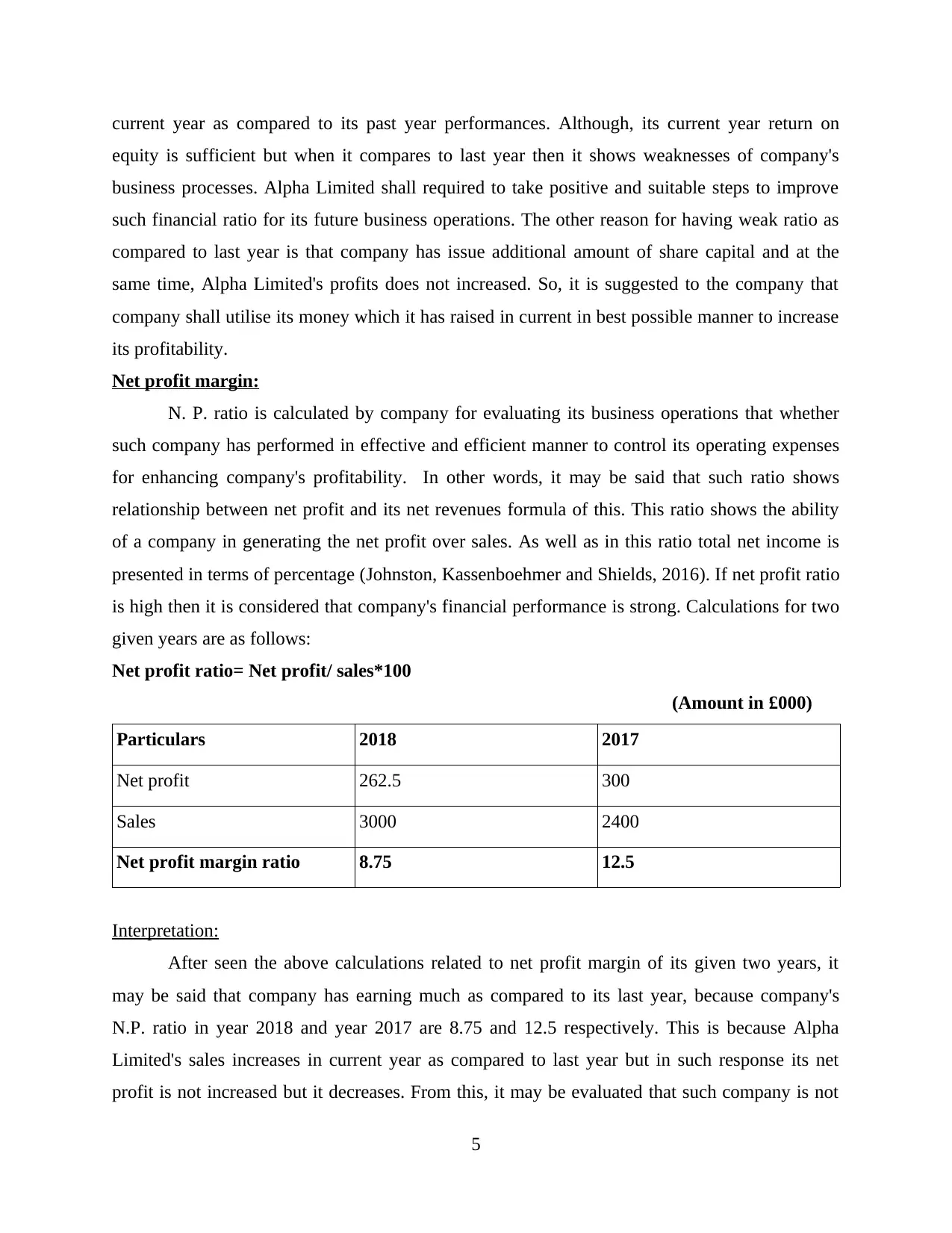
current year as compared to its past year performances. Although, its current year return on
equity is sufficient but when it compares to last year then it shows weaknesses of company's
business processes. Alpha Limited shall required to take positive and suitable steps to improve
such financial ratio for its future business operations. The other reason for having weak ratio as
compared to last year is that company has issue additional amount of share capital and at the
same time, Alpha Limited's profits does not increased. So, it is suggested to the company that
company shall utilise its money which it has raised in current in best possible manner to increase
its profitability.
Net profit margin:
N. P. ratio is calculated by company for evaluating its business operations that whether
such company has performed in effective and efficient manner to control its operating expenses
for enhancing company's profitability. In other words, it may be said that such ratio shows
relationship between net profit and its net revenues formula of this. This ratio shows the ability
of a company in generating the net profit over sales. As well as in this ratio total net income is
presented in terms of percentage (Johnston, Kassenboehmer and Shields, 2016). If net profit ratio
is high then it is considered that company's financial performance is strong. Calculations for two
given years are as follows:
Net profit ratio= Net profit/ sales*100
(Amount in £000)
Particulars 2018 2017
Net profit 262.5 300
Sales 3000 2400
Net profit margin ratio 8.75 12.5
Interpretation:
After seen the above calculations related to net profit margin of its given two years, it
may be said that company has earning much as compared to its last year, because company's
N.P. ratio in year 2018 and year 2017 are 8.75 and 12.5 respectively. This is because Alpha
Limited's sales increases in current year as compared to last year but in such response its net
profit is not increased but it decreases. From this, it may be evaluated that such company is not
5
equity is sufficient but when it compares to last year then it shows weaknesses of company's
business processes. Alpha Limited shall required to take positive and suitable steps to improve
such financial ratio for its future business operations. The other reason for having weak ratio as
compared to last year is that company has issue additional amount of share capital and at the
same time, Alpha Limited's profits does not increased. So, it is suggested to the company that
company shall utilise its money which it has raised in current in best possible manner to increase
its profitability.
Net profit margin:
N. P. ratio is calculated by company for evaluating its business operations that whether
such company has performed in effective and efficient manner to control its operating expenses
for enhancing company's profitability. In other words, it may be said that such ratio shows
relationship between net profit and its net revenues formula of this. This ratio shows the ability
of a company in generating the net profit over sales. As well as in this ratio total net income is
presented in terms of percentage (Johnston, Kassenboehmer and Shields, 2016). If net profit ratio
is high then it is considered that company's financial performance is strong. Calculations for two
given years are as follows:
Net profit ratio= Net profit/ sales*100
(Amount in £000)
Particulars 2018 2017
Net profit 262.5 300
Sales 3000 2400
Net profit margin ratio 8.75 12.5
Interpretation:
After seen the above calculations related to net profit margin of its given two years, it
may be said that company has earning much as compared to its last year, because company's
N.P. ratio in year 2018 and year 2017 are 8.75 and 12.5 respectively. This is because Alpha
Limited's sales increases in current year as compared to last year but in such response its net
profit is not increased but it decreases. From this, it may be evaluated that such company is not
5
Paraphrase This Document
Need a fresh take? Get an instant paraphrase of this document with our AI Paraphraser

able to control its operating cost along with its cost of goods sold. As result, its profits is not
increased taking into account the fact that its sales still increasing. Therefore, it is suggested to
the company that it has to focus on reducing its operating expenses along with its cost of
production to increase its profitability in future and as a result, its net profit ratio shall get
improved.
Current ratio:
This is important ratio and an organisation shall required to calculate such ratio to
evaluate its liquidity position in short run. In other words, a company shall required to calculate
such ratio to ascertain its capacity in paying its short term liabilities (i.e. current liabilities) with
the help of its current assets by converting them in cash easily (Veprauskaitė and Adams, 2013).
Calculations of such ratio for Alpha Limited for given two years are as follows:
Current ratio= Current assets/ current liabilities
(Amount in £000)
Particulars 2018 2017
Current assets 1035 757.5
Current liabilities 1110 322.5
Current ratio 0.93 2.35
Interpretation:
From the above results, it may be calculated that company has current ratio 0.93 and 2.35
in year 2018 and year 2017 respectively. This mean that company is not able to pay its current
liabilities with the help of its current assets. After deep analysis it may say that it is happen
because Alpha Limited current liabilities increases in current year as compared to last year.
Although, current assets also increases but not in proportion of its current liabilities. Therefore,
company shall require to find reasons regarding huge gap between its current liabilities and take
appropriate actions to improve its current ratio to show better liquidity position.
So management staff of above organization shall give more emphasis on reducing its
current liabilities as possible because this is the main reason for having weak liquidity position of
such organisation.
Average receivable days / debtors collection period:
6
increased taking into account the fact that its sales still increasing. Therefore, it is suggested to
the company that it has to focus on reducing its operating expenses along with its cost of
production to increase its profitability in future and as a result, its net profit ratio shall get
improved.
Current ratio:
This is important ratio and an organisation shall required to calculate such ratio to
evaluate its liquidity position in short run. In other words, a company shall required to calculate
such ratio to ascertain its capacity in paying its short term liabilities (i.e. current liabilities) with
the help of its current assets by converting them in cash easily (Veprauskaitė and Adams, 2013).
Calculations of such ratio for Alpha Limited for given two years are as follows:
Current ratio= Current assets/ current liabilities
(Amount in £000)
Particulars 2018 2017
Current assets 1035 757.5
Current liabilities 1110 322.5
Current ratio 0.93 2.35
Interpretation:
From the above results, it may be calculated that company has current ratio 0.93 and 2.35
in year 2018 and year 2017 respectively. This mean that company is not able to pay its current
liabilities with the help of its current assets. After deep analysis it may say that it is happen
because Alpha Limited current liabilities increases in current year as compared to last year.
Although, current assets also increases but not in proportion of its current liabilities. Therefore,
company shall require to find reasons regarding huge gap between its current liabilities and take
appropriate actions to improve its current ratio to show better liquidity position.
So management staff of above organization shall give more emphasis on reducing its
current liabilities as possible because this is the main reason for having weak liquidity position of
such organisation.
Average receivable days / debtors collection period:
6

This ratio provides information about its debtors which help the company in evaluating
its customer's response. Such information involves average collection period up-to which its
debtors make payment to the company. In other words, average collection period is a period of
time it takes up to which an organisation may receive its payments from the debtors (Opstrup and
Villadsen, 2015). Calculations are as follows:
Debtors collection period= Average receivables / sales*365 days
(Amount in £000)
Particulars 2018 2017
Average receivables 600 450
Sales 3000 2400
Average receivable period 73 days 68 days
Interpretation:
After analysis the above results related to Average receivable period, it is clearly evident
that company has average collection 73 days and 68 days in year 2018 and year 2017
respectively. This is due to having more sales in current year as compared to last year but less
increment in its average receivables in proportion to its sales. This ratio of two year shows that
company has received its sales amount from the debtor late by 5 days in year 2018 as compared
to year 2017. Alpha Limited shall require to take suitable steps to reduce its average collection
period. Therefore, it is recommended that Alpha Limited should restrict this by discovering those
debtors who makes delay in making payment and attempt to recover such sum from these
debtors in quick manner.
Average Payable days’ / Creditors payment period:
As name suggest, this ratio provides the details to the company about its creditors. This
means that such helps an organisation in providing the average period up-to which creditors
received their payments from the company (Finke, 2013). Formula to calculate this along with its
calculations for given two years are as follows:
Creditors payment period= Average payables / purchase*365 days
(Amount in £000)
Particulars 2018 2017
7
its customer's response. Such information involves average collection period up-to which its
debtors make payment to the company. In other words, average collection period is a period of
time it takes up to which an organisation may receive its payments from the debtors (Opstrup and
Villadsen, 2015). Calculations are as follows:
Debtors collection period= Average receivables / sales*365 days
(Amount in £000)
Particulars 2018 2017
Average receivables 600 450
Sales 3000 2400
Average receivable period 73 days 68 days
Interpretation:
After analysis the above results related to Average receivable period, it is clearly evident
that company has average collection 73 days and 68 days in year 2018 and year 2017
respectively. This is due to having more sales in current year as compared to last year but less
increment in its average receivables in proportion to its sales. This ratio of two year shows that
company has received its sales amount from the debtor late by 5 days in year 2018 as compared
to year 2017. Alpha Limited shall require to take suitable steps to reduce its average collection
period. Therefore, it is recommended that Alpha Limited should restrict this by discovering those
debtors who makes delay in making payment and attempt to recover such sum from these
debtors in quick manner.
Average Payable days’ / Creditors payment period:
As name suggest, this ratio provides the details to the company about its creditors. This
means that such helps an organisation in providing the average period up-to which creditors
received their payments from the company (Finke, 2013). Formula to calculate this along with its
calculations for given two years are as follows:
Creditors payment period= Average payables / purchase*365 days
(Amount in £000)
Particulars 2018 2017
7
⊘ This is a preview!⊘
Do you want full access?
Subscribe today to unlock all pages.

Trusted by 1+ million students worldwide
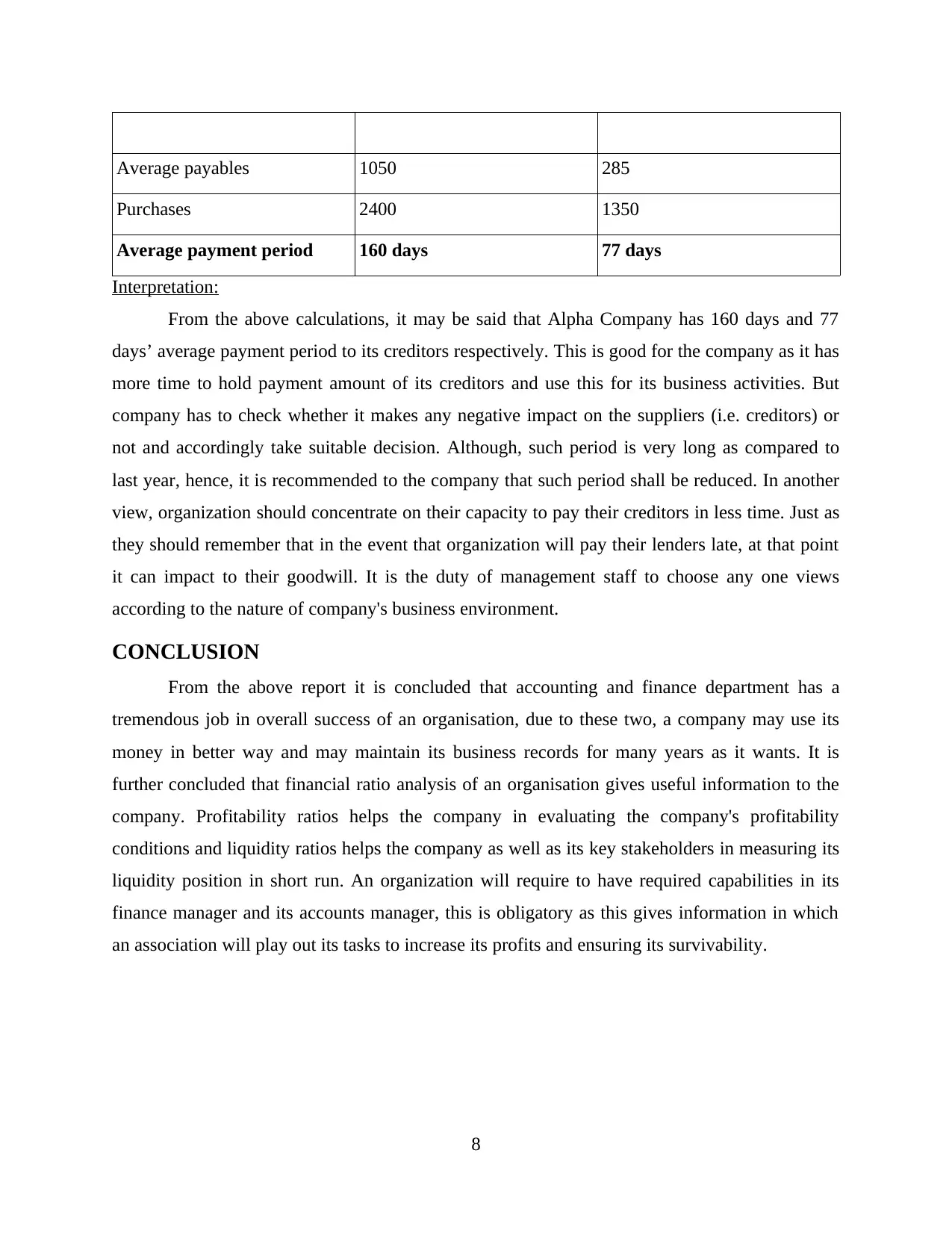
Average payables 1050 285
Purchases 2400 1350
Average payment period 160 days 77 days
Interpretation:
From the above calculations, it may be said that Alpha Company has 160 days and 77
days’ average payment period to its creditors respectively. This is good for the company as it has
more time to hold payment amount of its creditors and use this for its business activities. But
company has to check whether it makes any negative impact on the suppliers (i.e. creditors) or
not and accordingly take suitable decision. Although, such period is very long as compared to
last year, hence, it is recommended to the company that such period shall be reduced. In another
view, organization should concentrate on their capacity to pay their creditors in less time. Just as
they should remember that in the event that organization will pay their lenders late, at that point
it can impact to their goodwill. It is the duty of management staff to choose any one views
according to the nature of company's business environment.
CONCLUSION
From the above report it is concluded that accounting and finance department has a
tremendous job in overall success of an organisation, due to these two, a company may use its
money in better way and may maintain its business records for many years as it wants. It is
further concluded that financial ratio analysis of an organisation gives useful information to the
company. Profitability ratios helps the company in evaluating the company's profitability
conditions and liquidity ratios helps the company as well as its key stakeholders in measuring its
liquidity position in short run. An organization will require to have required capabilities in its
finance manager and its accounts manager, this is obligatory as this gives information in which
an association will play out its tasks to increase its profits and ensuring its survivability.
8
Purchases 2400 1350
Average payment period 160 days 77 days
Interpretation:
From the above calculations, it may be said that Alpha Company has 160 days and 77
days’ average payment period to its creditors respectively. This is good for the company as it has
more time to hold payment amount of its creditors and use this for its business activities. But
company has to check whether it makes any negative impact on the suppliers (i.e. creditors) or
not and accordingly take suitable decision. Although, such period is very long as compared to
last year, hence, it is recommended to the company that such period shall be reduced. In another
view, organization should concentrate on their capacity to pay their creditors in less time. Just as
they should remember that in the event that organization will pay their lenders late, at that point
it can impact to their goodwill. It is the duty of management staff to choose any one views
according to the nature of company's business environment.
CONCLUSION
From the above report it is concluded that accounting and finance department has a
tremendous job in overall success of an organisation, due to these two, a company may use its
money in better way and may maintain its business records for many years as it wants. It is
further concluded that financial ratio analysis of an organisation gives useful information to the
company. Profitability ratios helps the company in evaluating the company's profitability
conditions and liquidity ratios helps the company as well as its key stakeholders in measuring its
liquidity position in short run. An organization will require to have required capabilities in its
finance manager and its accounts manager, this is obligatory as this gives information in which
an association will play out its tasks to increase its profits and ensuring its survivability.
8
Paraphrase This Document
Need a fresh take? Get an instant paraphrase of this document with our AI Paraphraser

9
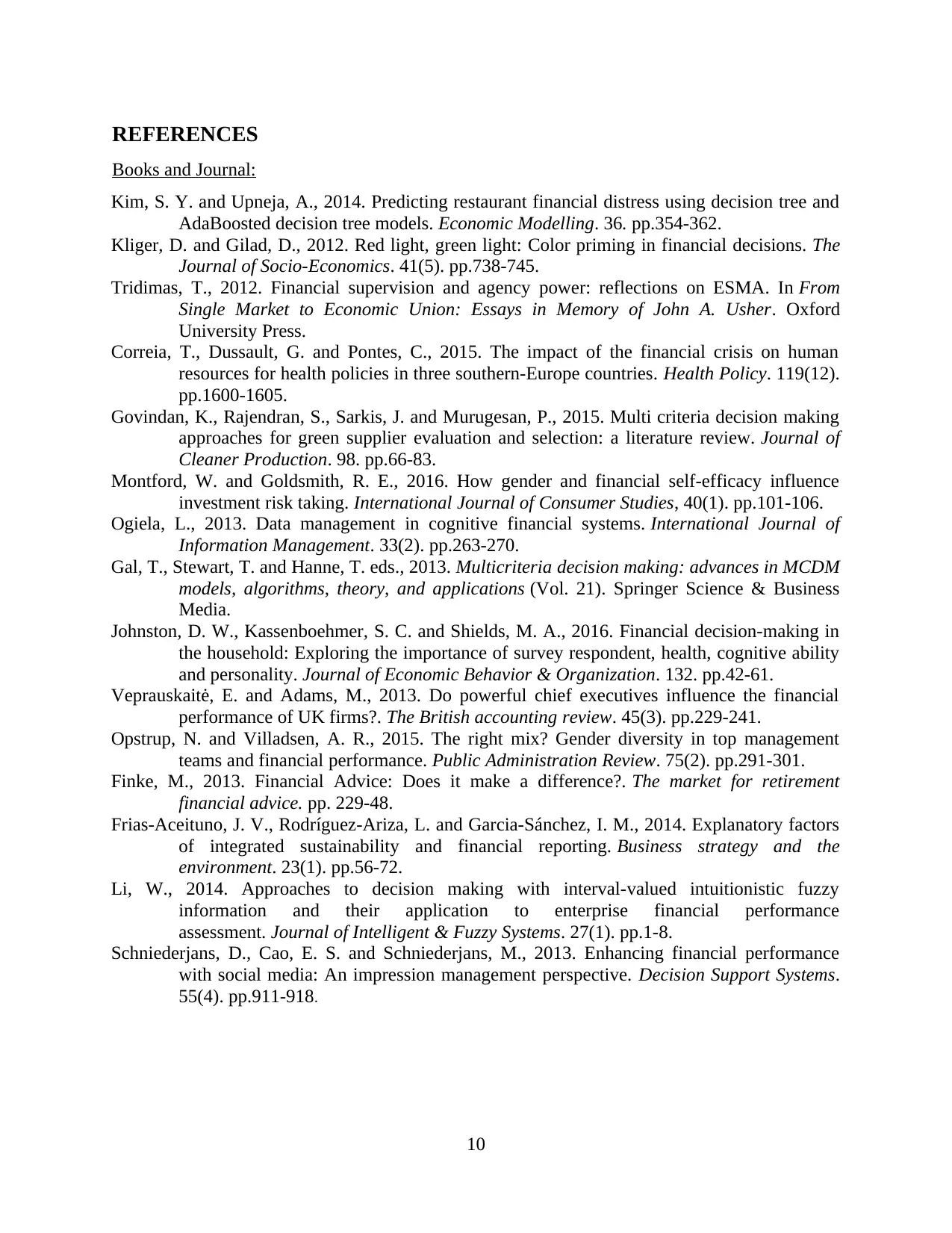
REFERENCES
Books and Journal:
Kim, S. Y. and Upneja, A., 2014. Predicting restaurant financial distress using decision tree and
AdaBoosted decision tree models. Economic Modelling. 36. pp.354-362.
Kliger, D. and Gilad, D., 2012. Red light, green light: Color priming in financial decisions. The
Journal of Socio-Economics. 41(5). pp.738-745.
Tridimas, T., 2012. Financial supervision and agency power: reflections on ESMA. In From
Single Market to Economic Union: Essays in Memory of John A. Usher. Oxford
University Press.
Correia, T., Dussault, G. and Pontes, C., 2015. The impact of the financial crisis on human
resources for health policies in three southern-Europe countries. Health Policy. 119(12).
pp.1600-1605.
Govindan, K., Rajendran, S., Sarkis, J. and Murugesan, P., 2015. Multi criteria decision making
approaches for green supplier evaluation and selection: a literature review. Journal of
Cleaner Production. 98. pp.66-83.
Montford, W. and Goldsmith, R. E., 2016. How gender and financial self‐efficacy influence
investment risk taking. International Journal of Consumer Studies, 40(1). pp.101-106.
Ogiela, L., 2013. Data management in cognitive financial systems. International Journal of
Information Management. 33(2). pp.263-270.
Gal, T., Stewart, T. and Hanne, T. eds., 2013. Multicriteria decision making: advances in MCDM
models, algorithms, theory, and applications (Vol. 21). Springer Science & Business
Media.
Johnston, D. W., Kassenboehmer, S. C. and Shields, M. A., 2016. Financial decision-making in
the household: Exploring the importance of survey respondent, health, cognitive ability
and personality. Journal of Economic Behavior & Organization. 132. pp.42-61.
Veprauskaitė, E. and Adams, M., 2013. Do powerful chief executives influence the financial
performance of UK firms?. The British accounting review. 45(3). pp.229-241.
Opstrup, N. and Villadsen, A. R., 2015. The right mix? Gender diversity in top management
teams and financial performance. Public Administration Review. 75(2). pp.291-301.
Finke, M., 2013. Financial Advice: Does it make a difference?. The market for retirement
financial advice. pp. 229-48.
Frias‐Aceituno, J. V., Rodríguez‐Ariza, L. and Garcia‐Sánchez, I. M., 2014. Explanatory factors
of integrated sustainability and financial reporting. Business strategy and the
environment. 23(1). pp.56-72.
Li, W., 2014. Approaches to decision making with interval-valued intuitionistic fuzzy
information and their application to enterprise financial performance
assessment. Journal of Intelligent & Fuzzy Systems. 27(1). pp.1-8.
Schniederjans, D., Cao, E. S. and Schniederjans, M., 2013. Enhancing financial performance
with social media: An impression management perspective. Decision Support Systems.
55(4). pp.911-918.
10
Books and Journal:
Kim, S. Y. and Upneja, A., 2014. Predicting restaurant financial distress using decision tree and
AdaBoosted decision tree models. Economic Modelling. 36. pp.354-362.
Kliger, D. and Gilad, D., 2012. Red light, green light: Color priming in financial decisions. The
Journal of Socio-Economics. 41(5). pp.738-745.
Tridimas, T., 2012. Financial supervision and agency power: reflections on ESMA. In From
Single Market to Economic Union: Essays in Memory of John A. Usher. Oxford
University Press.
Correia, T., Dussault, G. and Pontes, C., 2015. The impact of the financial crisis on human
resources for health policies in three southern-Europe countries. Health Policy. 119(12).
pp.1600-1605.
Govindan, K., Rajendran, S., Sarkis, J. and Murugesan, P., 2015. Multi criteria decision making
approaches for green supplier evaluation and selection: a literature review. Journal of
Cleaner Production. 98. pp.66-83.
Montford, W. and Goldsmith, R. E., 2016. How gender and financial self‐efficacy influence
investment risk taking. International Journal of Consumer Studies, 40(1). pp.101-106.
Ogiela, L., 2013. Data management in cognitive financial systems. International Journal of
Information Management. 33(2). pp.263-270.
Gal, T., Stewart, T. and Hanne, T. eds., 2013. Multicriteria decision making: advances in MCDM
models, algorithms, theory, and applications (Vol. 21). Springer Science & Business
Media.
Johnston, D. W., Kassenboehmer, S. C. and Shields, M. A., 2016. Financial decision-making in
the household: Exploring the importance of survey respondent, health, cognitive ability
and personality. Journal of Economic Behavior & Organization. 132. pp.42-61.
Veprauskaitė, E. and Adams, M., 2013. Do powerful chief executives influence the financial
performance of UK firms?. The British accounting review. 45(3). pp.229-241.
Opstrup, N. and Villadsen, A. R., 2015. The right mix? Gender diversity in top management
teams and financial performance. Public Administration Review. 75(2). pp.291-301.
Finke, M., 2013. Financial Advice: Does it make a difference?. The market for retirement
financial advice. pp. 229-48.
Frias‐Aceituno, J. V., Rodríguez‐Ariza, L. and Garcia‐Sánchez, I. M., 2014. Explanatory factors
of integrated sustainability and financial reporting. Business strategy and the
environment. 23(1). pp.56-72.
Li, W., 2014. Approaches to decision making with interval-valued intuitionistic fuzzy
information and their application to enterprise financial performance
assessment. Journal of Intelligent & Fuzzy Systems. 27(1). pp.1-8.
Schniederjans, D., Cao, E. S. and Schniederjans, M., 2013. Enhancing financial performance
with social media: An impression management perspective. Decision Support Systems.
55(4). pp.911-918.
10
⊘ This is a preview!⊘
Do you want full access?
Subscribe today to unlock all pages.

Trusted by 1+ million students worldwide
1 out of 12
Related Documents
Your All-in-One AI-Powered Toolkit for Academic Success.
+13062052269
info@desklib.com
Available 24*7 on WhatsApp / Email
![[object Object]](/_next/static/media/star-bottom.7253800d.svg)
Unlock your academic potential
Copyright © 2020–2025 A2Z Services. All Rights Reserved. Developed and managed by ZUCOL.





